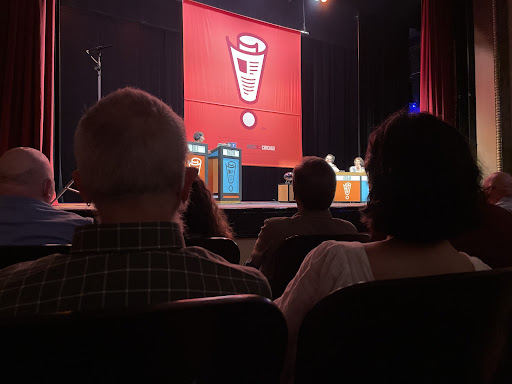
I now know how the sausage is made—and, frankly, that knowledge makes me love it even more. Of course, the sausage of which I speak is metaphorical, standing for the weekly National Public Radio (NPR) news quiz, Wait Wait… Don’t Tell Me! I learned the show’s secrets by going to a live taping this summer. I don’t want to spoil too much for you, but if you’re anything like me—a quiz lover and public radio aficionado who’s gotten his weekly news from Wait Wait since middle school—the live taping is a magical experience. If you’ve ever enjoyed listening to Bill Kurtis’s silky baritone delivery contrasting with bouncy, news-related limericks, you’ll love seeing his face light up when contestants guess correctly. The news can be boring, but Wait Wait makes it fun—doubly so when you’re in the room where it happens.
In June 2022, Wait Wait switched from taping its shows at the Chase Bank Auditorium in the Loop to taping the show at the Studebaker Theater on Michigan Avenue. Along with an easy 30-minute Metra ride from Hyde Park, the Studebaker Theater is the perfect size for a show like Wait, Wait. It’s big enough to feel enveloped by the crowd’s laughter after a particularly bad pun, yet small enough that you can easily find your seat and clearly make out the panelists’ faces. Speaking of seats, there wasn’t a single empty one. I sat down 20 minutes before the show began, which gave me plenty of time to absorb the room’s ambiance and get to know the people around me. Though the 65+ demographic was certainly well-represented (perhaps unsurprisingly, given that, y’know…it’s public radio), I wasn’t the youngest person there. There were a few families with their kids, and a group of what appeared to be high schoolers. (As an aside, if you’re the type of high schooler who likes to go to public radio quiz shows, you might like UChicago.)
I found the beauty of attending a live taping to be threefold: you get the show on a Thursday instead of waiting until Saturday; you get to experience parts of the show that get cut from the published version; and, most importantly, you experience a new visual dimension above and beyond the faceless audio from your podcast app. The airwaves just aren’t wide enough to fit every joke.
I’ll admit that the first benefit was most useful when it came to bragging to my friends and family, dangling facts and storylines in front of them. I got to feel smug for a whole two-ish days until the show ran on Saturday.
Unfortunately, the NPR editors must’ve somehow heard my teasing and decided to punish me for my crimes—whole questions and segments got cut. There was a question near the beginning of the show about corn sweat causing heat waves which didn’t make the final cut. This was devastating, since it was the seed for a joke that recurred through the rest of the show: whenever a panelist couldn’t figure out the correct response, they’d deadpan “corn sweat”. There were a few more moments like this that had the crowd in stitches. I’d list them, but, honestly, you just had to be there.
There was a whole segment of retakes at the end, too, which—as someone who’s only ever listened to the final versions of the show before—was especially interesting. I have a healthy respect for puzzles (I moonlight as The Maroon’s crossword editor), so it was particularly fun to try and place the out-of-context clips that the panelists had to re-enunciate.
The highlight of the show, however, had to be seeing the voices of my Saturday afternoons in person. There’s something so much more real about seeing them jot down puns and test their microphones and take a try or two to perfect the delivery of a current events–related punchline. It was a bit of a shock in the beginning—years of audio-only interaction meant I didn’t have an accurate image of what some of these people looked like. For some reason, I always imagined Bill Kurtis with a beard, but he’s immaculately clean-shaven.
There was also a whole other dimension of comedy that only comes through visually. That realization feels obvious as I type it now, but it was a revelation as I sat in the theater. When you listen from the comfort of your home or car, you can’t see the spinning light machine in the center of the stage suddenly illuminate as the auditorium dims and the panelists enter to raucous applause. You don’t see the panelists’ evil grins between the moment they think up a good pun and the moment they get to say it. You don’t see Bill Kurtis smile knowingly and shake his head at the audience as a caller gets an answer wrong. It’s unique in all the right ways. The radio certainly does a wonderful job, but the live show is an experience impossible to capture with sound alone. You just can’t get it on the radio.








